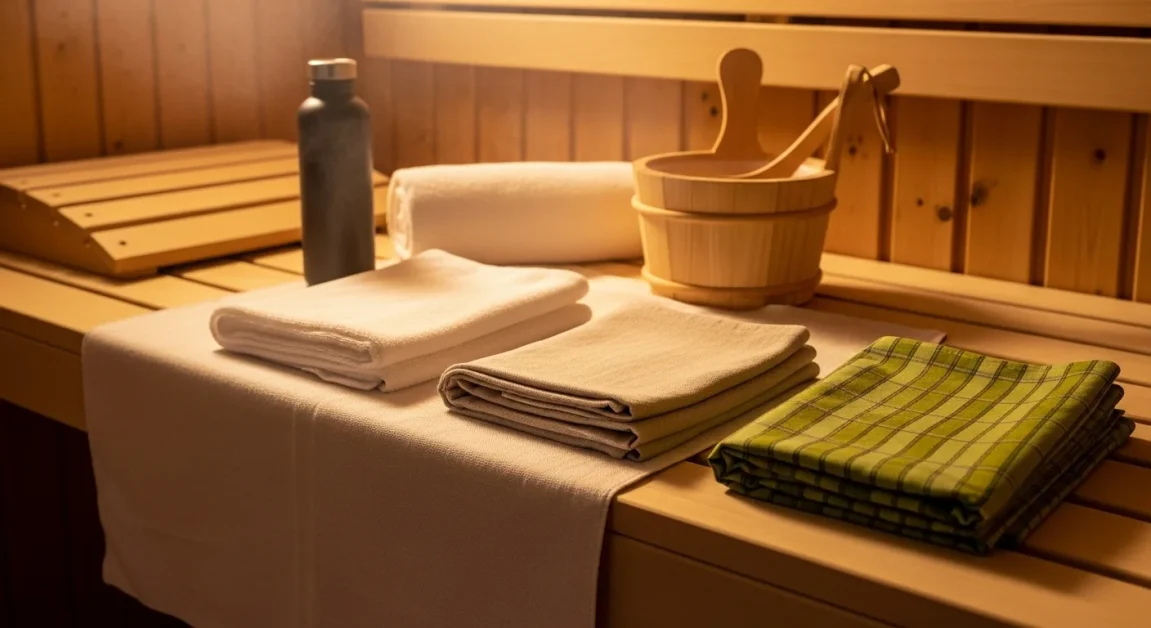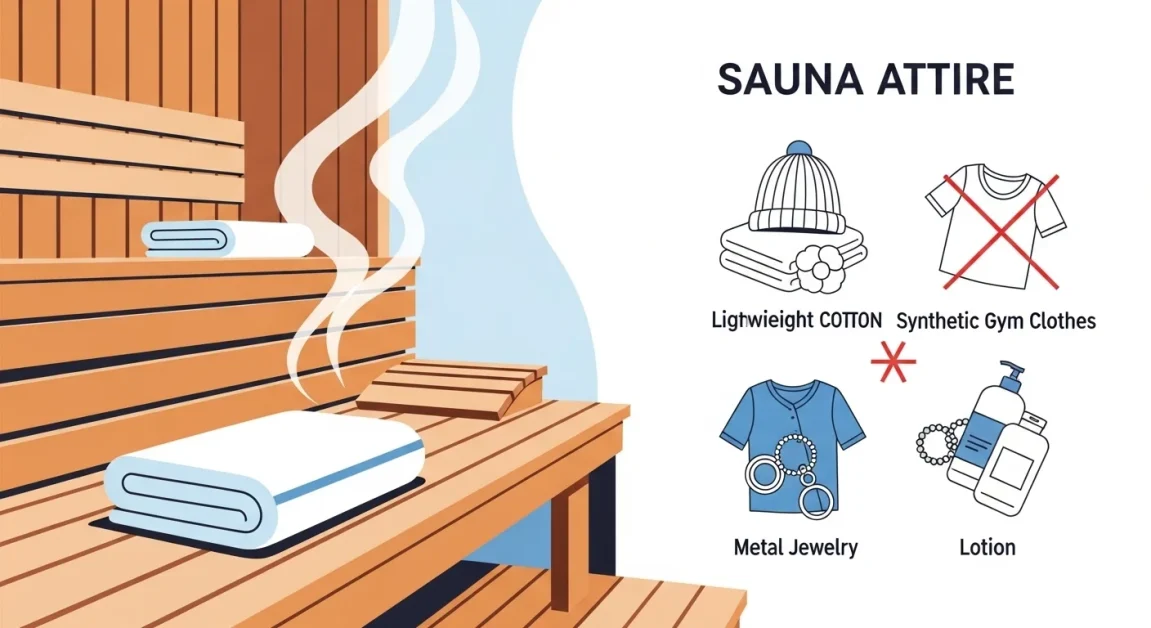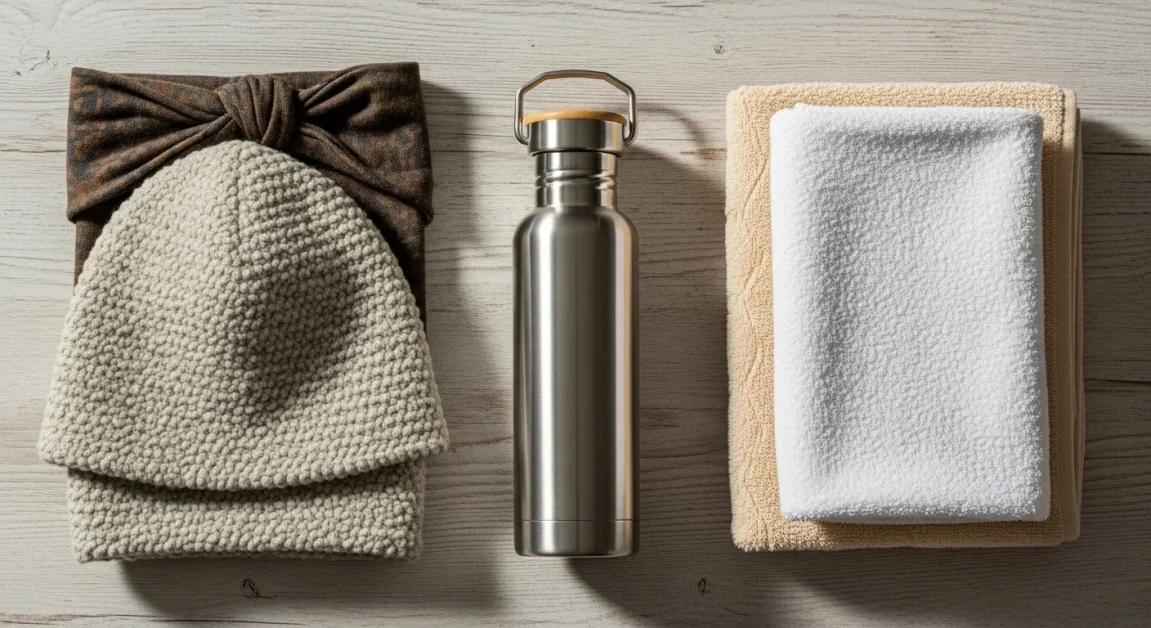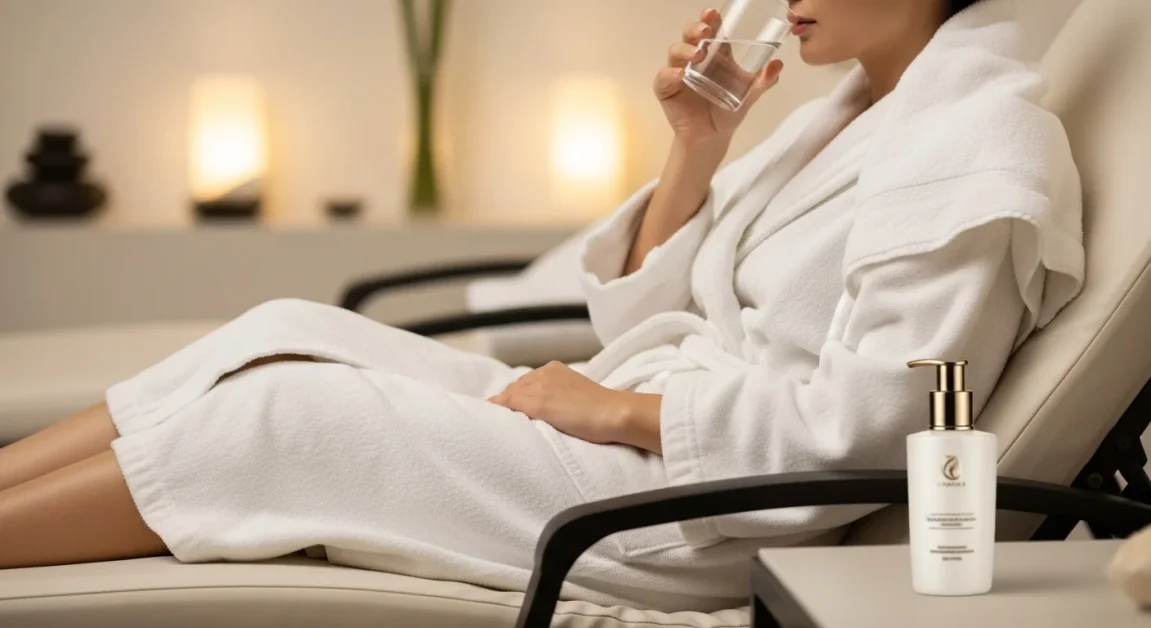How To Dress For The Sauna:
Comfort and common sense rule in the sauna. Keep it simple, skip anything that could get hot or trap heat, and just focus on relaxing. The whole point is to sweat it out and feel good after.
- Guide to Sauna Attire: Look Good, Feel Great, Stay Safe
- Why Sauna Attire Matters
- 10 Must-Know Sauna Dressing Tips
- Women's Sauna Attire
- Sauna Clothing Guide
- Common Problems with Sauna Clothing and Solutions
- Sauna Safety Tips
- Navigating Sauna Etiquette: My Attire Choices
- After the Sauna: What to Wear and Do
- AI and Technology in Saunas: Track Your Health Smarter
- 🔥 Sauna Safety Tips: Stay Comfortable & Healthy
- Stats, Facts & Real-World Case Studies
- FAQs
Consult with a doctor before starting any new weight loss regimen.
To sauna comfortably, wear loose clothing or go naked for the traditional experience. Remember sauna etiquette by showering before and after, bringing a towel, and avoiding jewellery. Stay hydrated, listen to your body, and maintain a comfortable length of time in the sauna.

Specific recommendations:
- Cotton: Cotton is the most famous choice for sauna clothing because it is soft, absorbent, and breathable. Avoid wearing tight-fitting cotton clothing, as this can restrict airflow and make you feel uncomfortable.
- Linen: Linen is another good option for sauna clothing, as it is breathable and moisture-wicking. Yet, linen can be more expensive than cotton, and it may require greater absorbency.
- Bamboo: Bamboo fabric is becoming increasingly popular for sauna clothing because it is naturally antibacterial and antifungal. It is also very soft and breathable.
Here’s the cheat sheet if you just skimmed:
| Do | Don’t |
|---|---|
| Bring a clean towel | Wear metal jewelry |
| Wear loose cotton if needed | Go in with makeup on |
| Sit on a towel | Wear tight or synthetic clothes |
| Tie your hair up | Bring your phone into the heat |
| Go in scent-free | Overdress or overthink it |
Guide to Sauna Attire: Look Good, Feel Great, Stay Safe
Stepping into a sauna is like entering a cozy, steamy oasis, but what you wear (or don’t wear) can make or break your experience. The right attire keeps you comfortable, safe, and respectful of the shared space. From breathable fabrics to smart accessories, here’s everything you need to know to dress like a sauna pro.
If you’re unsure which materials feel best in high heat, check out our guide to the best fabrics for sauna for breathable, skin-friendly options.
Why Sauna Attire Matters
Saunas are hot. The right clothing (or lack thereof) lets your body sweat naturally, keeps you comfy, and maintains hygiene for everyone. Nobody wants to sit on a bench soaked with someone else’s sweat, right? Plus, some saunas have specific dress codes, towels only in some, swimsuits in others. Dressing smart ensures you’re respecting the vibe while keeping your skin happy.
Fabrics to Love
Choose materials that can handle the heat and humidity while keeping you cool and comfortable:
- Cotton: Lightweight, breathable, and sweat-wicking, perfect for loose-fitting shorts or tops.
- Linen: Airy and natural, it lets your skin breathe in the steamy heat.
- Bamboo: Soft, eco-friendly, and great at managing moisture.
- Wool: A surprising pick, but lightweight wool (like merino) wicks sweat and stays fresh.
These natural fibers keep you comfy, prevent irritation, and hold up well in the sauna’s intense environment.
Fabrics to Avoid
Steer clear of these sauna no-nos:
- Synthetic Fabrics (Polyester, Nylon, Spandex): They trap heat and sweat, making you feel like a steamed dumpling. Some can even release chemicals or melt in high heat.
- Heavy or Tight Clothing: These block sweat, raise your body temp too fast, and can lead to overheating.
- Sweaty Gym Clothes: They’re often synthetic, cling to your skin, and get smelly fast. Save them for the treadmill.
10 Must-Know Sauna Dressing Tips
Ready to sauna like a champ? Follow these tips for a safe, relaxing, and etiquette-friendly experience:
- Keep It Minimal
Less is more in the sauna’s heat. A towel wrapped around you is often enough. In some European-style saunas, going nude is the norm, just check the rules first! - Bring Clean Towels
One towel to sit on (for hygiene) and another to dry off post-session. It’s a small gesture that keeps the space fresh for everyone. - Choose Lightweight Clothing
If you’re not a towel-only person, opt for loose cotton shorts or a tank top. Avoid anything tight or synthetic that traps heat. - Go Barefoot Inside
Leave shoes at the door; sneakers or flip-flops don’t belong in the sauna. If you need footwear outside the sauna, shower slides work great. - Ditch the Bling
Jewelry, watches, and piercings heat up fast and can burn your skin. Leave them in your locker to avoid an “ouch” moment. - Skip Swimsuits with Metal or Plastic
Bathing suits with metal rings or plastic clips can get hot or melt. Stick to simple, plain swimsuits for co-ed saunas. - Go Makeup-Free
Makeup melts in minutes, clogging pores and leaving you with a streaky mess. Let your skin breathe for a natural glow. - Tie Up Long Hair
Keep hair off your neck with a loose bun or braid. A towel or sauna hat can protect freshly washed locks from the heat. - Avoid Scents
Lotions, perfumes, or body sprays can become overpowering in a small, hot space. Shower before entering to keep it fresh. - Leave Your Phone Behind
Heat can fry your device, and scrolling defeats the purpose of unwinding. Give yourself (and your phone) a break.
Before stepping inside, it’s worth reviewing a few sauna safety tips to make sure you stay comfortable and avoid common mistakes.
Extra Tips for a Luxe Sauna Experience 💆♀️
- Hydrate Like a Pro: Drink water before and after to stay refreshed. Avoid heavy meals or alcohol, which can increase fatigue and dehydration.
- Move Slowly: Limit movement in the sauna to avoid dizziness. If you need to adjust, do it carefully to stay balanced.
- Keep a Safe Distance: Stay at least a foot from the heat source to prevent burns.
- Check the Space: Ensure there’s enough room to sit comfortably. If needed, bring a portable chair for extra comfort.
- Skip the Sunscreen: It clogs pores and blocks sweat. Apply before your session and wash off afterward.
- Consider Supplements: Vitamins C, E, or B can help combat fatigue, but check with a doctor first.
- Avoid Hot Water Bottles: They’re a fire hazard in the sauna’s heat.
Women’s Sauna Attire
There’s no universal “allowed” attire for women’s saunas; it depends on the sauna’s rules, cultural norms, and your comfort level. Some prefer towels, others opt for swimsuits or lightweight cotton clothing. Always check the sauna’s guidelines and choose what feels right for you.
Sauna Clothing Guide
What is Sauna Clothing?
Sauna clothing, made from materials like neoprene or PVC, traps body heat to boost perspiration during workouts or sauna sessions. It supports weight loss, detoxification, and enhanced fitness performance by creating a sauna-like environment.
Benefits
- Muscle Warm-Up: Warms muscles faster, reducing injury risk.
- Increased Calorie Burn: Elevates body temperature, potentially boosting calorie expenditure.
- Detoxification: Promotes sweating to aid in toxin elimination.
- Water Weight Loss: Facilitates rapid water weight loss for short-term goals.
What to Wear
Choose loose-fitting, breathable cotton clothing to allow air circulation and comfort.
What to Avoid

- Tight Synthetic Clothing: Polyester or nylon traps sweat, preventing skin from breathing.
- Metal Accessories: Zippers, buttons, or jewelry can heat up and cause burns.
- Sunscreen, Lotions, Oils: These clog pores, irritate skin, and hinder sweating. Apply sunscreen before and wash off after.
- Fragrances: Can cause irritation or allergic reactions in the heat.
Sauna Footwear Guide

In private saunas, going barefoot is fine. In public saunas, wear flip-flops or rubber slippers for hygiene and safety. Avoid sneakers or sweaty socks, as they’re unsuitable for the heat and sauna surfaces.
What Not to Wear
- Jewelry, Watches, Piercings: Metal heats up fast and can burn skin.
- Makeup, Perfume, Lotion: These can clog pores, cause odors, or irritate skin in the heat.
Hygiene and Etiquette
Shower before entering to keep the sauna clean. Sit on a towel to protect the benches and yourself. Avoid reusing sweaty gym clothes. Respect shared spaces for everyone’s comfort.
Must-Have Accessories

- Water Bottle: Stay hydrated during sessions.
- Sauna Hat/Headwrap: Protects your scalp from excessive heat.
- Extra Towel: One for sitting, another for drying off.
Post-Sauna Attire
Change into loose, breathable clothes to cool down comfortably. Bring a fresh towel and clean undergarments to refresh after your session.

Common Problems with Sauna Clothing and Solutions
1. Discomfort and Skin Irritation
Problem: Many users experience discomfort or skin irritation during prolonged use.
Solution: Choose sauna clothing made from high-quality, hypoallergenic materials and wear a moisture-wicking layer underneath.
2. Sizing Issues
Problem: Finding the correct size can be challenging as sauna clothing must be snug but not restrictive.
Solution: Refer to brand-specific sizing charts and customer reviews, and opt for adjustable options.
3. Durability Concerns
Problem: Sauna clothing can tear easily, especially during intense workouts.
Solution: Look for products with reinforced seams and durable materials like neoprene.
4. Effectiveness Doubts
Problem: Users may doubt if sauna clothing is truly effective for weight loss.
Solution: Understand that it promotes temporary water weight loss; combine it with a balanced diet and exercise for lasting results.
5. Cleaning and Maintenance
Problem: Improper cleaning can lead to damage or odors.
Solution: Hand wash with mild detergent and air dry to maintain quality.
6. Breathability and Overheating
Problem: Overheating can occur if sauna clothing is used for extended periods.
Solution: Stay hydrated, limit use duration, and take breaks if you feel unwell.
7. Odor Issues
Problem: Excessive sweating can lead to odors if clothing is not cleaned properly.
Solution: Wash immediately after use with odor-neutralizing agents like baking soda.
8. Limited Mobility
Problem: Tight sauna clothing can restrict movement during exercise.
Solution: Choose flexible options designed for full range of motion workouts.
9. Material Allergies
Problem: Materials like neoprene may cause allergic reactions.
Solution: Opt for hypoallergenic materials if you have sensitive skin.
10. High Cost
Problem: High-quality sauna clothing can be expensive.
Solution: Consider reputable mid-range brands and check customer reviews for affordability and durability.
Sauna Safety Tips
Using a sauna can be a relaxing and beneficial experience, but it’s important to follow safety guidelines to avoid risks like dehydration, overheating, or injury.
For those looking to intensify sweating or add variety to their sessions, here’s how to choose the best sauna suit to buy.
- Stay Hydrated
- Drink 16–20 ounces of water before and after your sauna session to replace fluids lost through sweating. Consider electrolyte drinks post-session to restore sodium and potassium. Avoid alcohol and caffeinated beverages, as they can increase dehydration risk.
- Limit Session Time
- Keep sessions to 15–20 minutes for traditional saunas or steam rooms, and up to 30 minutes for infrared saunas. Beginners should start with 5–10 minutes to allow the body to adjust to the heat. Exit immediately if you feel dizzy, nauseous, or lightheaded.
- Monitor Temperature
- Traditional saunas typically range from 70–100°C (158–212°F), infrared saunas from 49–60°C (120–140°F), and steam rooms from 40–50°C (104–122°F). Start at the lower end of these ranges, especially if new to saunas, to avoid overheating.
- Cool Down Gradually
- After exiting, rest for 5–10 minutes in a cooler area before taking a lukewarm shower. Avoid sudden cold plunges, as rapid temperature changes can stress the cardiovascular system.
- Check Health Conditions
- Consult a doctor before using a sauna if you have heart conditions, high or low blood pressure, diabetes, are pregnant, or are on medications like diuretics or beta-blockers. Children under 12 and those with recent Botox injections should also seek medical advice.
- Avoid Alcohol and Heavy Meals
- Alcohol increases dehydration and can cause dangerous drops in blood pressure. Avoid heavy meals before a session, as they divert blood flow to digestion, increasing discomfort.
- Use a Towel
- Sit or lie on a clean towel to maintain hygiene, protect your skin from hot surfaces, and prevent slipping. Avoid direct contact with heaters or hot rocks to prevent burns.
- Buddy System
- If you have health concerns or are new to saunas, consider using the sauna with a friend or family member for safety. This is especially important for those with heart conditions or low blood pressure.
- Listen to Your Body
- Exit immediately if you experience dizziness, nausea, headache, or rapid heartbeat. These are signs of overheating or dehydration. Never push through discomfort in the name of endurance.
- Fire and Electrical Safety (Home Saunas)
- Ensure proper installation with dedicated circuits and GFCI-protected outlets. Avoid placing flammable items like towels near heaters. Never use outdoor saunas indoors, and schedule annual electrical inspections.
- Sauna Etiquette (Public Saunas)
- Shower before entering to maintain cleanliness. Keep noise low, respect others’ space, and follow posted rules or attendant instructions.
- Avoid Lotions and Electronics
- Skip lotions or oils, as they can make surfaces slippery and increase burn risk. Leave electronics outside, as heat and moisture can damage them and pose safety hazards.
Additional Notes:
Regular sauna use (2–4 times per week) is generally safe for healthy individuals, but always prioritize moderation and self-awareness.
Saunas can offer benefits like improved circulation, muscle relaxation, and stress relief, but they’re not risk-free. A 2010 World Sauna Championships incident highlighted the dangers of extreme heat, resulting in a fatality due to prolonged exposure at 230°F.
For children, use lower temperatures and limit sessions to 5–10 minutes under supervision.
Top 5 Must-Have Sauna Essentials
If you want to make the most of your sauna sessions, these basics are non-negotiable:
- A cotton or linen towel – Soft, absorbent, and gentle on skin.
- Breathable cotton or linen clothing – Keeps you comfortable without trapping heat.
- A sauna hat or wide-brimmed hat – Helps protect your head from excess heat.
- A reusable water bottle – Stay hydrated before, during, and after.
- Flip-flops or sandals – Keep feet clean and avoid slipping on wet floors.
Top 10 Sauna Clothing & Accessories
For those who like to be fully prepared, here’s a more complete list:
- Sauna water bottle (insulated to keep drinks cool)
- Sauna suit (for those looking to intensify sweating)
- Sauna hat or headband
- Cotton or bamboo socks
- Sauna belt or waistband
- Sauna towel (dedicated just for sauna use)
- Sauna sandals or flip-flops
- Moisture-wicking t-shirt and shorts set
- Lightweight sauna robe
- Sauna eye shades for extra relaxation
Navigating Sauna Etiquette: My Attire Choices
Sauna etiquette is crucial for a harmonious environment. Women should wear bikinis or one-piece swimsuits, while men should wear swim trunks or shorts, all in breathable fabrics. For weight loss, wear minimal clothing, bring a towel, and choose loose-fitting options. These attire choices ensure a positive and respectful experience for everyone.

What to Wear in a Sauna to Lose Weight
While saunas offer many health benefits, including relaxation, improved circulation, and detoxification, they are not a magic bullet for weight loss. Wearing minimal clothing or nothing at all is best for weight loss in a sauna. This allows maximum sweating and heat exposure, aiding in burning calories and promoting weight loss.
After the Sauna: What to Wear and Do
Finishing up in the sauna is just as important as the session itself. Here’s a simple post-sauna routine to help you feel refreshed and keep your skin happy:
Once your session is over, rehydrate and refuel with these ideas on what to eat and drink after the sauna

- Rest – Take it easy for a bit so your body can fully recover.
- Cool down slowly – Step into a cool (not ice-cold) shower or relax in a cool room for a few minutes.
- Hydrate – Drink a glass or two of water to replace lost fluids.
- Dry off gently – Pat your skin with a clean towel instead of rubbing.
- Moisturize – Apply a light, nourishing moisturizer to lock in hydration.
- Change into fresh clothes – Soft, breathable fabrics like cotton feel best after a sauna.
Related Article Section
- Sauna Baths: The Ultimate Detox for Your Body: Explore the incredible detoxifying benefits of sauna baths and how they can help cleanse your body from toxins.
- Infrared Sauna Blanket: Embrace the Warmth: Learn about the benefits and uses of an infrared sauna blanket, a portable and convenient way to enjoy the benefits of sauna therapy.
Relevant Sources of Information: Sauna Suit Benefits: Learn about the scientific benefits and research supporting the use of proper sauna clothing. Understand how dressing right can enhance your sauna sessions.
Remember:
Consult your doctor before using a sauna if you have any health conditions. Listen to your body, and don’t push yourself too hard. Saunas are a great way to relax and improve overall health, but are not a quick fix for weight loss.
AI and Technology in Saunas: Track Your Health Smarter
Modern saunas are no longer just about relaxing—they can now integrate wearable tech and AI-powered apps to help you monitor your body, stay safe, and maximize benefits.
1. Wearable Sensors
- Heart Rate Monitors: Track your cardiovascular response during sessions. Some smartwatches can alert you if your heart rate exceeds safe levels.
- Temperature Sensors: Wearables can measure skin temperature and core body heat to prevent overheating.
- Hydration Trackers: Some devices monitor sweat loss and estimate how much water you need before, during, and after your sauna session.
2. AI-Powered Apps
- Session Monitoring: Apps like DeepSeek or Grok-style wellness platforms let you set target temperatures, durations, and track calories lost during sauna sessions.
- Personalized Recommendations: AI analyzes your session data and gives tips on optimal session lengths, hydration, and recovery times.
- Integration with Fitness Apps: Some apps sync sauna data with fitness trackers (Apple Health, Google Fit, Garmin) to give a complete picture of your activity, heart rate, and calorie burn.
3. Smart Sauna Equipment
- Connected Infrared & Traditional Saunas: Modern units allow smartphone control for heat settings, humidity, and session timers.
- Voice Assistant Integration: Compatible with AI assistants like ChatGPT, Bing AI, or Alexa to start sessions, adjust heat, or log your sauna activity.
- Safety Alerts: Automated warnings if temperatures get too high or if your session exceeds safe limits based on your heart rate or hydration levels.
Benefits of AI & Tech Integration
- Improved safety for beginners and those with health conditions.
- Better tracking for weight loss, recovery, and detox sessions.
- Personalized insights to optimize sauna frequency, duration, and temperature.
Pro Tip:
Using a wearable smartwatch or AI-powered sauna app can turn a relaxing sauna session into a fully informed wellness routine, helping you track heart health, sweating, and hydration like a pro.
🔥 Sauna Safety Tips: Stay Comfortable & Healthy
🧖♂️ Avoid wearing too many layers – this traps heat and can cause discomfort. Saunas reach 140-150°F (60-65°C)!
⏱️ Limit sessions to 15-20 minutes and stay hydrated with water before and after.
🚿 Always shower before entering to keep the sauna clean for everyone.
👂 Listen to your body – exit immediately if you feel dizzy or unwell.
💡 Pro Tip: Bring a towel to sit on for hygiene and comfort!
🔗 Also check out our hot tubs patios collection
Stats, Facts & Real-World Case Studies
Adding real-world data and proven facts makes your sauna guide more credible and actionable.
Case Study: Finnish Sauna Culture
A long-term study in Finland followed 1,600 participants over 20 years and found that those who used a sauna 4–7 times per week had a 50% lower risk of heart disease compared to occasional users. This highlights the cardiovascular benefits of regular sauna sessions when combined with proper attire and safety practices.
Hygiene Fact
Sitting on a towel isn’t just for comfort. Research shows that shared sauna benches without towels can harbor bacteria like Staphylococcus aureus, which can cause skin infections. Using a clean towel protects both you and others while maintaining a hygienic environment.
Infrared Sauna Tip
Infrared saunas heat the body directly without raising the air temperature above 140°F (60°C). This means that light cotton clothing or a simple towel is sufficient, even for longer sessions, reducing the risk of overheating while still maximizing sweating and detox benefits.

















6 Comments